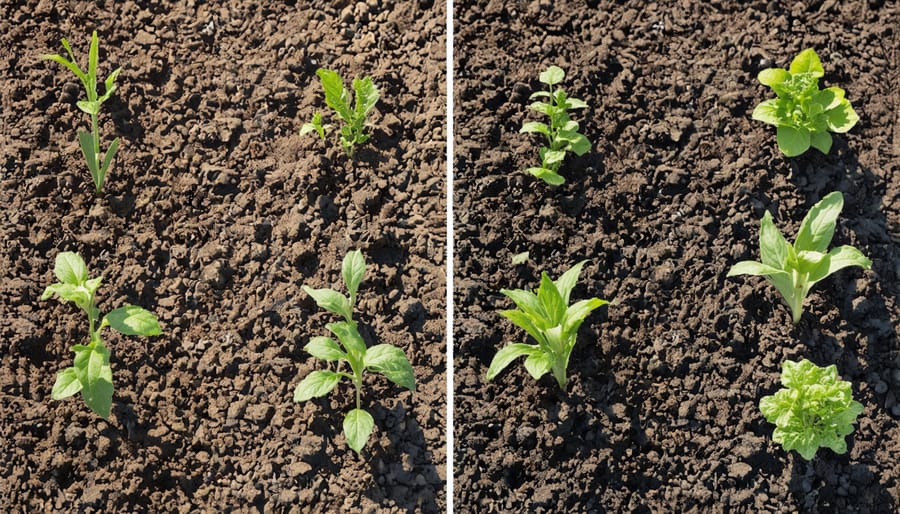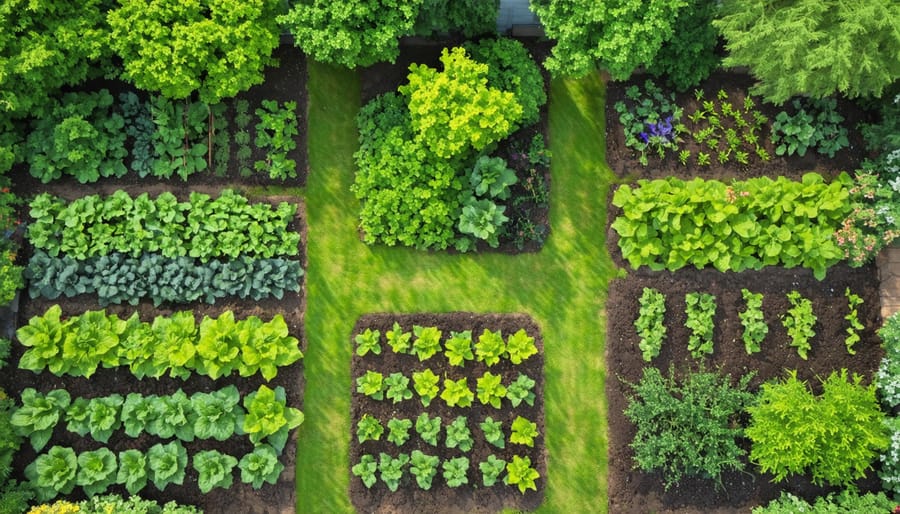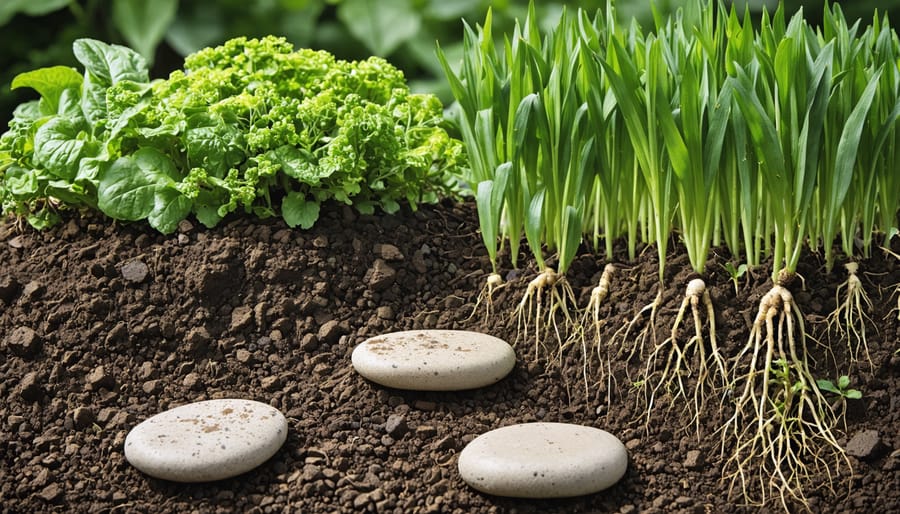Transform your garden into a powerful climate solution by harnessing nature’s own carbon-capturing abilities. Every square foot of healthy soil can store up to 10 pounds of carbon dioxide, making your backyard a vital ally in the fight against climate change.
Natural climate solutions – from restoring wetlands to protecting ancient forests – could provide up to 37% of the emissions reductions needed by 2030 to keep global warming below 2°C. But it’s in our own gardens where this global movement takes root. By building healthy soil, planting native species, and practicing regenerative gardening techniques, we’re not just growing plants – we’re growing hope for a cooler planet.
The beauty of natural climate solutions lies in their simplicity: working with nature, not against it. When we compost kitchen scraps, mulch our beds, or plant a tree, we’re participating in Earth’s ancient carbon cycle. These practices not only help stabilize our climate but also create more resilient gardens that better withstand extreme weather events.
As gardeners, we stand at the intersection of global challenge and local action. Our hands in the soil aren’t just tending plants – they’re helping write the story of our planet’s future.
How Your Garden’s Soil Fights Climate Change
The Carbon Storage Powerhouse in Your Backyard
Right in your backyard, there’s a hidden champion in the fight against climate change – your garden soil! Think of soil as nature’s own carbon bank, quietly storing away greenhouse gases that would otherwise warm our planet. When you dig into healthy garden soil, you’re actually touching one of Earth’s most effective tools for carbon storage in garden soil.
Here’s how it works: Plants pull carbon dioxide from the air through photosynthesis, then send much of it down to their roots. In the soil, this carbon becomes part of organic matter – those rich, dark components that make soil healthy. Beneficial organisms like earthworms and microscopic fungi help lock this carbon away, sometimes for hundreds of years!
The exciting part is that your garden can store more carbon than you might think. A single acre of healthy soil can hold several tons of carbon. By nurturing your soil through good gardening practices, you’re not just growing beautiful plants – you’re helping our planet breathe easier. It’s amazing to think that while you’re tending to your tomatoes or pruning your perennials, you’re also part of a global climate solution!

Your Soil’s Hidden Climate Warriors
Beneath your garden’s surface lies a remarkable team of climate champions – the beneficial soil microorganisms that work tirelessly to keep our planet healthy. These microscopic heroes play a crucial role in storing carbon and building resilience against climate change.
Think of your soil as a bustling underground city where billions of bacteria, fungi, and other tiny organisms create a complex network of life. They break down organic matter, transforming dead plants and leaves into rich, carbon-storing humus. When these microbes are thriving, they can help your garden capture and store more carbon than a small forest!
What’s even more fascinating is how these soil inhabitants help plants weather climate extremes. They form partnerships with plant roots, helping them access water during droughts and protecting them from floods and temperature swings. By nurturing these underground allies through organic gardening practices, you’re not just growing healthier plants – you’re actively participating in nature’s own climate solution.
The best part? You don’t need special equipment or expertise to support these microscopic warriors. Simple practices like adding compost, avoiding chemical fertilizers, and minimizing soil disturbance will help them thrive and do their vital work.
Climate-Smart Soil Practices for Your Garden
No-Till Gardening: Keep Carbon Where It Belongs
Every time you till your garden, you’re releasing stored carbon into the atmosphere – but there’s a better way! No-till gardening is a game-changing approach to building carbon-rich soil while creating a thriving garden ecosystem.
Instead of disrupting soil structure with heavy tilling, no-till methods work with nature by layering organic materials on top of existing soil. Think of it as creating a cozy blanket for your garden! Start by laying down cardboard to suppress weeds, then add alternating layers of brown materials (leaves, straw) and green materials (grass clippings, kitchen scraps).
The benefits are impressive: soil maintains its natural structure, earthworms and beneficial microorganisms flourish, and water retention improves dramatically. Best of all, carbon stays locked in the soil where it belongs, rather than escaping into the atmosphere.
Getting started is simple: clear your garden space, lay down your cardboard barrier, and begin building those nutrient-rich layers. For existing gardens, gradually transition by reducing tilling depth each season until you eliminate it completely. Add mulch regularly to suppress weeds and feed the soil naturally.
Remember, healthy soil is living soil! By avoiding tilling, you’re not just growing better plants – you’re actively contributing to climate change solutions right in your own backyard.

Cover Crops: Your Soil’s Natural Shield
Cover crops are like a cozy blanket for your soil, protecting and nourishing it when your main crops aren’t growing. These hard-working plants do more than just fill empty space – they’re soil-building champions that help fight climate change right in your backyard.
By planting cover crops like clover, rye, or buckwheat during off-seasons, you’re creating a living shield that prevents soil erosion and keeps valuable nutrients from washing away. These plants send their roots deep into the soil, creating natural pathways that improve drainage and soil structure. As a bonus, many cover crops are excellent at capturing carbon dioxide from the atmosphere and storing it safely in the soil.
“I’ve seen dramatic improvements in my garden’s soil since I started using cover crops,” says Master Gardener Sarah Chen. “The soil is more crumbly, holds moisture better, and my vegetables are thriving.”
Getting started with cover crops is simple. In fall, after harvesting your summer crops, scatter your chosen cover crop seeds and lightly rake them in. Come spring, you can either till them into the soil as “green manure” or cut them down and leave them as mulch. Both methods return valuable organic matter to your soil, creating a healthier growing environment for your next round of plants.
Remember, healthy soil is our greatest ally in the fight against climate change, and cover crops are one of the easiest ways to be part of the solution.

Composting: Turn Waste into Climate Gold
Transform your kitchen scraps and yard waste into garden gold through composting – nature’s way of recycling organic matter into rich, fertile soil. This simple yet powerful practice not only reduces waste but also helps fight climate change by storing carbon in the ground.
Start by collecting your “greens” (nitrogen-rich materials like fruit and vegetable scraps, coffee grounds, and fresh grass clippings) and “browns” (carbon-rich materials such as dry leaves, straw, and paper). Layer these materials in roughly a 3:1 ratio of browns to greens, keeping the pile as moist as a wrung-out sponge.
The key to successful composting is maintaining good airflow. Turn your pile every few weeks using a garden fork to speed up decomposition and prevent unpleasant odors. In about 3-6 months, you’ll have dark, crumbly compost that smells like fresh earth.
For urban gardeners with limited space, try vermicomposting with red wiggler worms. These wonderful creatures can transform your kitchen scraps into nutrient-rich castings right in your kitchen or balcony.
By incorporating compost into your garden soil, you’re not just improving plant growth – you’re creating a carbon sink that helps mitigate climate change. The improved soil structure also better retains water, making your garden more resilient to both drought and flooding.
Remember: every bucket of compost you create is one less bag of waste in the landfill and one more step toward a healthier planet.
Mulching: Nature’s Climate-Fighting Blanket
Think of mulch as nature’s cozy blanket for your soil – it’s not just about keeping your garden looking tidy, it’s a powerful ally in our fight against climate change. When you spread a layer of organic mulch around your plants, you’re actually creating a mini-ecosystem that works wonders for both your garden and the planet.
There are several excellent mulching materials to choose from, each with its own superpowers. Wood chips and bark slowly decompose, adding rich organic matter to your soil while locking in carbon. Straw and leaves make perfect seasonal mulch, protecting soil from temperature extremes and reducing water evaporation by up to 70%. Even grass clippings can be repurposed as mulch, returning valuable nutrients to the soil.
The climate-fighting benefits of mulching are impressive. It helps soil retain moisture, reducing the need for frequent watering and conserving this precious resource. By keeping soil temperatures stable, mulch creates ideal conditions for beneficial microorganisms that improve soil health and increase carbon storage. It also naturally suppresses weeds, eliminating the need for chemical herbicides.
The key is to maintain a 2-4 inch layer of mulch, keeping it slightly away from plant stems to prevent rot. Refresh your mulch annually, and you’ll be creating a resilient garden that actively contributes to climate solutions while requiring less maintenance from you.
Seasonal Care for Climate-Resilient Soil
Maintaining healthy soil throughout the year is crucial for both your garden’s success and our planet’s well-being. By following these seasonal care guidelines and integrated soil management practices, you’ll create a resilient foundation that supports both abundant growth and carbon sequestration.
Spring brings the perfect opportunity to prepare your soil for the growing season. Start by gently loosening winter-compacted soil with a broadfork or garden fork, being careful not to disturb the soil structure too deeply. Add a layer of compost and incorporate early-season cover crops like clover or peas to naturally boost nitrogen levels.
Summer care focuses on maintaining soil moisture and protecting beneficial microorganisms. Apply a 2-3 inch layer of organic mulch around your plants to retain water and keep soil temperatures stable. Consider using straw, leaves, or grass clippings, which will gradually break down and enrich your soil.
As autumn approaches, it’s time to replenish your soil’s nutrients. Plant cover crops like rye or vetch to prevent erosion and add organic matter. These “green manures” protect your soil through winter while fixing nutrients for the following season.
Winter might seem quiet above ground, but your soil can still be working hard. Leave root systems of spent plants in place to maintain soil structure, and add a thick layer of organic matter to insulate the ground. This protection allows beneficial organisms to stay active longer and continues the natural process of building healthy soil.
Remember to regularly test your soil pH and nutrient levels throughout the year, adjusting your care routine based on the results. By following these seasonal practices, you’re not just nurturing your garden – you’re creating a sustainable carbon sink that helps combat climate change while producing beautiful, healthy plants.
As gardeners, we often focus on the beauty and bounty of our plots, but our impact extends far beyond our garden gates. Every time we nurture healthy soil, we’re actually participating in one of the most powerful climate solutions available to us. By implementing the soil management practices we’ve discussed, each of us can make a meaningful difference in the fight against climate change.
Remember, when you add compost to your garden, choose no-till methods, or plant cover crops, you’re not just improving your garden’s productivity – you’re helping to sequester carbon and build resilience against extreme weather events. These simple actions, multiplied across millions of home gardens worldwide, create a significant positive impact on our climate.
The beauty of garden-based climate action lies in its accessibility. Whether you tend a small urban plot or manage a large suburban garden, every square foot of soil under your care represents an opportunity to be part of the solution. As you watch your garden thrive through these sustainable practices, you’re also contributing to a healthier planet for future generations.
Let’s embrace our role as climate gardeners. Start small, celebrate your successes, and share your knowledge with fellow gardeners. Together, our individual actions create a tapestry of positive change, proving that sometimes the most powerful solutions can grow right in our own backyards.




